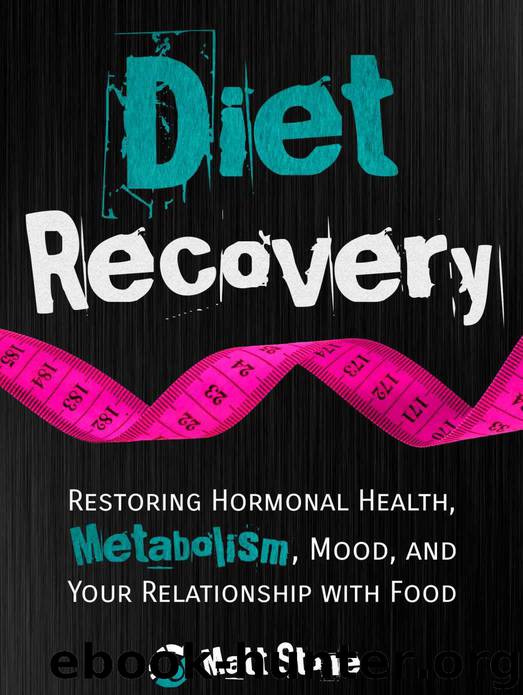Diet Recovery: Restoring Hormonal Health, Metabolism, Mood, and Your Relationship with Food (Diet Recovery Series Book 1) by Matt Stone

Author:Matt Stone [Stone, Matt]
Language: eng
Format: epub
Publisher: Archangel Ink
Published: 2013-12-02T22:00:00+00:00
The Specifics of the High-Everything Diet
“Just as your body became a fat storing machine because of your habits (reduced caloric intake) you can just as easily instruct it to become a fat burning machine. The first and most critical step in losing fat is to prepare your body for the task ahead by raising your metabolism as high as you can. For the majority of us, this is accomplished by (take a deep breath ladies) gradually increasing your caloric intake—in layman’s terms, eating more!”
-Ric Rooney; Secrets of a Professional Dieter
I created RRARF to reiterate that this process is not just a diet, but a comprehensive mind/body/lifestyle protocol. But the “high-everything diet” in its purest form is what is used as the food component of it. You can eat whatever you like, but I believe that the most important fundamental aspects of the diet is that it is comprised of mostly wholesome, unrefined, unadulterated foods and contains plenty of fat, a lot of carbohydrates, a lot of calories, and sufficient protein. In other words, “high in everything.”
Certain aspects are worth mentioning in terms of specifically cranking this up to increase metabolic activity. The reasons for each of the following guidelines is discussed in great detail in my other books. Long-winded reasons aside, I believe the most potent version of the HED[1] to be:
1) Rich in saturated fats, particularly short and medium-chain triglycerides found in greatest abundance in dairy fats and coconut. Butyric acid, as we discussed earlier, has great potential to raise the metabolism, and milk and ice cream would be the ideal source from the feedback I’ve gathered so far – so long as you have a good tolerance for it. Sour cream is my favorite for savory dishes, and fatty cheeses like my favorite – Fromager D’Affinois, are totally fair game. Coconut is the best source of medium-chain triglycerides, and coconut milk and fresh and dried coconut are my favorite sources of MCT’s. Beef would be the third choice if you have a dislike or exhaustively-confirmed intolerance to the above. Chocolate is another rich source of saturated fats, and a totally acceptable food for refeeding. You don’t have to overdo it on the fats, and if one had to choose between a very high-fat diet and a very high-carbohydrate diet for raising mitochondrial activity – the high-carb version usually outperforms, but I think it depends on where you’re coming from. If you are coming from a low-fat diet, you probably need more fat at first. If you are coming from low-carb, you probably need way more carbohydrate and less fat at first.
2) Rich in unrefined carbohydrates. Starch is a great tool for increasing metabolic activity, as almost all of it metabolizes into glucose or short-chain fatty acids – both being the almighty metabolism stimulators. Root vegetables, corn, and rice tend to be the best tolerated overall. Potatoes and yams are the best friends of the HED freak. Corn and corn products (cornmeal, corn tortillas) are fantastic. Rice, white or brown depending on what you fare best on, is at the top of the list as well.
Download
This site does not store any files on its server. We only index and link to content provided by other sites. Please contact the content providers to delete copyright contents if any and email us, we'll remove relevant links or contents immediately.
Periodization Training for Sports by Tudor Bompa(8170)
Why We Sleep: Unlocking the Power of Sleep and Dreams by Matthew Walker(6618)
Paper Towns by Green John(5091)
The Immortal Life of Henrietta Lacks by Rebecca Skloot(4526)
The Sports Rules Book by Human Kinetics(4294)
Dynamic Alignment Through Imagery by Eric Franklin(4118)
ACSM's Complete Guide to Fitness & Health by ACSM(3989)
Kaplan MCAT Organic Chemistry Review: Created for MCAT 2015 (Kaplan Test Prep) by Kaplan(3940)
Introduction to Kinesiology by Shirl J. Hoffman(3726)
Livewired by David Eagleman(3684)
The Death of the Heart by Elizabeth Bowen(3552)
The River of Consciousness by Oliver Sacks(3541)
Alchemy and Alchemists by C. J. S. Thompson(3451)
Bad Pharma by Ben Goldacre(3357)
Descartes' Error by Antonio Damasio(3230)
The Emperor of All Maladies: A Biography of Cancer by Siddhartha Mukherjee(3068)
The Gene: An Intimate History by Siddhartha Mukherjee(3048)
The Fate of Rome: Climate, Disease, and the End of an Empire (The Princeton History of the Ancient World) by Kyle Harper(3003)
Kaplan MCAT Behavioral Sciences Review: Created for MCAT 2015 (Kaplan Test Prep) by Kaplan(2940)
